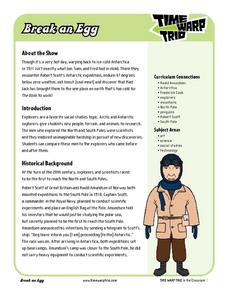Curated OER
Arctic Passage
Students plan a survival pack for severe Antarctic weather. They identify items necessary for survival in cold climates and which factors play a parat in keeping warm in the cold.
Curated OER
Climate Change
Ninth graders compare the Arctic and Antarctic. In this climate lesson students work in groups, research and complete an oral report or a poster.
Curated OER
Compare the Arctic with Antarctica Venn Diagram
In this Venn diagram worksheet, students compare and contrast the Arctic with Antarctica. They place the things that are different about the two geographic regions in the outer areas of the circles and the things that are similar in the...
Curated OER
Blubber Gloves
The ways that animals adapt to their environments is quite remarkable. In this life science lesson, fifth graders take a look at some of the ways that aquatic animals that live in Arctic or Antarctic waters survive. They perform an...
Polar Trec
Beacon Valley Weather
In Beacon Valley, katabatic winds regularly knock fit adults to the ground. The lesson compares the actual temperatures to the wind chill after factoring in katabatic winds in Beacon Valley. Scholars learn to calculate wind chill and...
NOAA
Please Pass the Salt
Salinity is the focus of two experimenters that work to answer the question, How does salt change the physical properties of water? Super scientists compare the freezing rate of salt and fresh water, combine the two waters to...
Curated OER
Adaptations of Fishes for Survival in Polar Environments
Learners compare the anatomy of temperature and polar fishes. They explore the adverse effects of cold on metabolism and physiology and discuss how polar fishes adapt to their environments. Comparisons are also made to the DNA sequences...
Curated OER
Frozen Out
Young scholars investigate how climate changes affect top predators in Arctic marine ecosystems. Students complete a worksheet and write a report based on their responses to a scientific paper.
Curated OER
Polar Pals: Polar Bears & Penguins
First graders complete a variety of activities about polar bears and penguins including the "Blubber Mitten" experiment. They culminate the unit by creating a visual representation comparing and contrasting the two animals.
Curated OER
Antarctica
Students explore the Antarctic continent, Australia's role in Antarctic exploration and development, the issues concerning Antarctica's future and the needs of the Antarctic community.
Curated OER
Break an Egg
Students research antarctic wildlife and create a diorama and fact sheet to present their research to the class. They create an Antarctic explorer's journal.
Curated OER
Ozone and Temperature Data Analysis, South Pole Antarctica
Students discuss the layers of the atmosphere, and the history of the ozone hole. They discuss the chemistry of the ozone formation. Students compare seasonal data collected with ozonesondes. They compare Antarctic and Arctic ozone hole...
Polar Trec
Ozone Data Comparison over the South Pole
Did you know the hole in the ozone is seasonal and filled by January every year? The instructional activity uses scientific measurements of the ozone over the South Pole to understand patterns. Scholars learn that the hole grew bigger...
Curated OER
Photosynthetically Available Radiation (PAR) Measurements Part 1: Calculating the Solar Constant using a TI-8
Twelfth graders are introduced to the term Photosynthetically Available Radiation. In groups, they participate in an experiment to determine how ecosystems survive the conditions in the Arctic. They calculate the amount of solar energy...
National Wildlife Federation
I Speak for the Polar Bears!
Climate change and weather extremes impact every species, but this lesson focuses on how these changes effect polar bears. After learning about the animal, scholars create maps of snow-ice coverage and examine the yearly variability and...
Curated OER
Polar Scientists: Polar Science
Research skills are extremely important and they can be linked to any subject. Get your class thinking about scientists that study the polar region, what they do, and how they get funded to continue their research. Each child uses a...
Polar Trec
Where is the World's Water?
Scholars discover the amount of the Earth's water in various locations such as the ocean, ice, the atmosphere, etc. They then make a model of the how much water those percentages represent. Finally, analysis questions bring the concepts...
Curated OER
Energy Flow in Ecosystems
Young scholars, in groups, create a slide show about the ecosystem and answer critical thinking questions based on their research.
Better Lesson
Better Lesson: Arctic v. Antarctic
Young scholars will be able to identify similarities and differences between two texts on the same topic. After reading and discussing books on the Arctic and Antarctic, they will use a Venn diagram and assorted images to compare and...
Better Lesson
Better Lesson: Arctic vs. Antarctic
Learners will be able to identify similarities and differences between two texts about the polar habitats by using a Venn diagram. Included in this lesson are guided questions to use while reading, a printable Venn Diagram, and pictures...
Woods Hole Oceanographic Institution
Polar Discovery: Compare the Poles
A detailed comparison of many aspects of the two polar regions. Includes physical features, seasons, weather, types of ice, plants and animals, human population, and climate change.
Woods Hole Oceanographic Institution
Polar Discovery: Compare the Poles: Ice
A comparison of the features of ice in the Arctic and the Antarctic. Looks at glaciers, icebergs, pack ice, and multi-year ice.
Woods Hole Oceanographic Institution
Woods Hole Oceanography Institute: Comparing the Poles
Have you ever wondered how the Arctic differs from the Antarctic? This resources contrasts the physical features, organisms and human impact of these two regions.
National Snow and Ice Data Center
National Snow and Ice Data Center: All About Sea Ice
An intensive look at sea ice, its characteristics, how it is formed, where it occurs, why it is so important, scientific research, its impact on early explorers' voyages, and so on. Antarctic and Arctic sea ice are compared for...

























